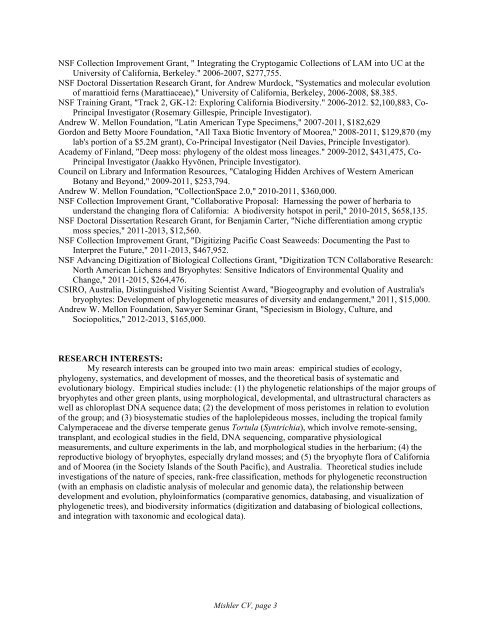see long CV for full list - University and Jepson Herbaria - University ...
see long CV for full list - University and Jepson Herbaria - University ...
see long CV for full list - University and Jepson Herbaria - University ...
You also want an ePaper? Increase the reach of your titles
YUMPU automatically turns print PDFs into web optimized ePapers that Google loves.
NSF Collection Improvement Grant, " Integrating the Cryptogamic Collections of LAM into UC at the<br />
<strong>University</strong> of Cali<strong>for</strong>nia, Berkeley." 2006-2007, $277,755.<br />
NSF Doctoral Dissertation Research Grant, <strong>for</strong> Andrew Murdock, "Systematics <strong>and</strong> molecular evolution<br />
of marattioid ferns (Marattiaceae)," <strong>University</strong> of Cali<strong>for</strong>nia, Berkeley, 2006-2008, $8.385.<br />
NSF Training Grant, "Track 2, GK-12: Exploring Cali<strong>for</strong>nia Biodiversity." 2006-2012. $2,100,883, Co-<br />
Principal Investigator (Rosemary Gillespie, Principle Investigator).<br />
Andrew W. Mellon Foundation, "Latin American Type Specimens," 2007-2011, $182,629<br />
Gordon <strong>and</strong> Betty Moore Foundation, "All Taxa Biotic Inventory of Moorea," 2008-2011, $129,870 (my<br />
lab's portion of a $5.2M grant), Co-Principal Investigator (Neil Davies, Principle Investigator).<br />
Academy of Finl<strong>and</strong>, "Deep moss: phylogeny of the oldest moss lineages." 2009-2012, $431,475, Co-<br />
Principal Investigator (Jaakko Hyvönen, Principle Investigator).<br />
Council on Library <strong>and</strong> In<strong>for</strong>mation Resources, "Cataloging Hidden Archives of Western American<br />
Botany <strong>and</strong> Beyond," 2009-2011, $253,794.<br />
Andrew W. Mellon Foundation, "CollectionSpace 2.0," 2010-2011, $360,000.<br />
NSF Collection Improvement Grant, "Collaborative Proposal: Harnessing the power of herbaria to<br />
underst<strong>and</strong> the changing flora of Cali<strong>for</strong>nia: A biodiversity hotspot in peril," 2010-2015, $658,135.<br />
NSF Doctoral Dissertation Research Grant, <strong>for</strong> Benjamin Carter, "Niche differentiation among cryptic<br />
moss species," 2011-2013, $12,560.<br />
NSF Collection Improvement Grant, "Digitizing Pacific Coast Seaweeds: Documenting the Past to<br />
Interpret the Future," 2011-2013, $467,952.<br />
NSF Advancing Digitization of Biological Collections Grant, "Digitization TCN Collaborative Research:<br />
North American Lichens <strong>and</strong> Bryophytes: Sensitive Indicators of Environmental Quality <strong>and</strong><br />
Change," 2011-2015, $264,476.<br />
CSIRO, Australia, Distinguished Visiting Scientist Award, "Biogeography <strong>and</strong> evolution of Australia's<br />
bryophytes: Development of phylogenetic measures of diversity <strong>and</strong> endangerment," 2011, $15,000.<br />
Andrew W. Mellon Foundation, Sawyer Seminar Grant, "Speciesism in Biology, Culture, <strong>and</strong><br />
Sociopolitics," 2012-2013, $165,000.<br />
RESEARCH INTERESTS:<br />
My research interests can be grouped into two main areas: empirical studies of ecology,<br />
phylogeny, systematics, <strong>and</strong> development of mosses, <strong>and</strong> the theoretical basis of systematic <strong>and</strong><br />
evolutionary biology. Empirical studies include: (1) the phylogenetic relationships of the major groups of<br />
bryophytes <strong>and</strong> other green plants, using morphological, developmental, <strong>and</strong> ultrastructural characters as<br />
well as chloroplast DNA sequence data; (2) the development of moss peristomes in relation to evolution<br />
of the group; <strong>and</strong> (3) biosystematic studies of the haplolepideous mosses, including the tropical family<br />
Calymperaceae <strong>and</strong> the diverse temperate genus Tortula (Syntrichia), which involve remote-sensing,<br />
transplant, <strong>and</strong> ecological studies in the field, DNA sequencing, comparative physiological<br />
measurements, <strong>and</strong> culture experiments in the lab, <strong>and</strong> morphological studies in the herbarium; (4) the<br />
reproductive biology of bryophytes, especially dryl<strong>and</strong> mosses; <strong>and</strong> (5) the bryophyte flora of Cali<strong>for</strong>nia<br />
<strong>and</strong> of Moorea (in the Society Isl<strong>and</strong>s of the South Pacific), <strong>and</strong> Australia. Theoretical studies include<br />
investigations of the nature of species, rank-free classification, methods <strong>for</strong> phylogenetic reconstruction<br />
(with an emphasis on cladistic analysis of molecular <strong>and</strong> genomic data), the relationship between<br />
development <strong>and</strong> evolution, phyloin<strong>for</strong>matics (comparative genomics, databasing, <strong>and</strong> visualization of<br />
phylogenetic trees), <strong>and</strong> biodiversity in<strong>for</strong>matics (digitization <strong>and</strong> databasing of biological collections,<br />
<strong>and</strong> integration with taxonomic <strong>and</strong> ecological data).<br />
Mishler <strong>CV</strong>, page 3



